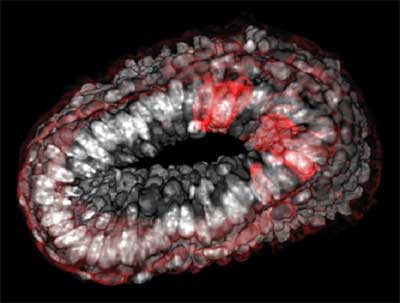| RIKEN Center for
Developmental Biology (CDB) 2-2-3 Minatojima minamimachi, Chuo-ku, Kobe 650-0047, Japan |
| The beginning of the beginning for the germline | ||
June 8, 2005 – Every cell in an individual’s body contains identical genetic information, but only a very few are able to use that information to contribute directly to the creation of a new individual. Such cells, known as germ cells, differ from the other somatic cells that make up the rest of the body in several very significant ways. Unlike somatic cells, the germ cells (which include both eggs and sperm) have the ability to shed and reacquire their epigenetic markings; to divide meiotically, resulting in a halving of the normal complement of chromosomes; and to fuse into a zygote that can then give rise to every type of cell needed for the development of a new individual, a developmental capacity, called totipotency.
Germ cells in many species inherit their unique identities very early in development. In mice, the process begins with a small cohort of a few dozen primordial germ cells, or PGCs, which appear at the region that separates the extraembryonic tissue from the embryo proper, then migrate inward, traversing the genital ridges on their way to colonize the gonads. The journey of these germline founders begins very early in the embryo’s history, at a stage when the nascent mouse looks more like a tiny cylinder clinging to the uterine wall. It is believed that the germ cells’ destiny is determined in large part in these early hours, with their initial segregation from their neighbors and the repression of signals that would otherwise prompt them to adopt a somatic fate. Now, in an article published in the advanced online edition of Nature magazine, Mitinori Saitou (Team Leader, Laboratory for Mammalian Germ Cell Biology), Yasuhide Ohinata and colleagues at the RIKEN CDB, working in collaboration with labs in the UK and the US, report the identification of a new factor in the specification of PGCs. This molecule, Blimp1 (for B-lymphocyte induced maturation protein) appears to function earlier than any known factor in the determination of the germline in mice. A screen of cDNAs from individual PGCs at embryonic stage 7.5 yielded a number of promising candidates for germ lineage determinants, including Blimp1, which was first identified as a factor in the differentiation of B cells into immunoglobulin-secreting plasma cells, which circulate in the bloodstream and function at the frontlines of the body’s immune response. “We thought it was intriguing to find that a factor functioning in such a terminal event as B cell differentiation might also be at work in the very earliest days of the embryo’s development,” notes Saitou, “It’s always interesting to find cases where the same molecule turns up in two very different contexts.” The team next tracked Blimp1-positive cells by in situ hybridization, which revealed Blimp1 expression in a thin swath of cells lying at the border between the extraembryonic ectoderm and the embryo itself. The onset of its expression was unexpectedly early, in the stage E6.25 epiblast, even before the process of gastrulation begins. Studies in which Blimp1 expression was monitored by a fluorescent protein expressed under the control of Blimp1 upstream elements confirmed that its expression began in a small number of cells in the epiblast which proliferated to about 40 cells by E7.5, nicely matching previous estimates of the number of founder PGCs. On tagging the Blimp1-expressing cells with the antibody for a second protein, stella, which is a definitive marker of nascent PGCs, the group found an almost perfect coincidence of the two proteins’ expression, pointing to a strong involvement of Blimp1. Turning next to Blimp1 function, Saitou et al created homozygous and heterozygous knockouts of the gene that let them study its full and partial loss of function. The effects of Blimp1 deficiency were broadly dose-dependent, with slightly more than half the normal number of PGCs in Blimp1+/- embryos and no normal-appearing PGCs in the null mutants, an effect that seemed to be linked to the failure of PGC genesis, rather than of cell proliferation or survival. Even those cells that did arise in the loss-of-function mutants behaved differently than their wildtype counterparts, with stunted proliferation and failure to disperse migrate being typical of the mutant PGCs. The gene expression profiles of the Blimp1-deficient PGC-like cells was also abnormal. In normal development, PGCs begin to express stella while at the same time inhibiting the expression of Hox-family genes; in the mutants, few stella-positive cells were detected and Hox gene expression was prevalent.
|
||
|
||
[ Contact ] Douglas Sipp : sipp@cdb.riken.jp TEL : +81-78-306-3043 RIKEN CDB, Office for Science Communications and International Affairs |
| Copyright (C) CENTER FOR DEVELOPMENTAL BIOLOGY All rights reserved. |
